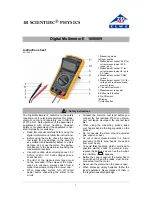
50
g) Current Measuring “A”
Do not exceed the maximum permitted input values. Do not touch any circuits or parts of circuits if
they may be subject to voltages higher than 33 V ACrms or 70 V DC! Danger to life!
The voltage in the measuring circuit must not exceed 1000 V.
Measuring >10 A must only be performed for max. 10 seconds and at 15 minute intervals.
Never measure any currents above 20 A in the A range and no currents above 600 mA in the mA/µA
range; otherwise the fuses trigger.
Always start current measurements at the highest measurement range and switch down to lower
ranges if necessary. Before connection of the meter and before measurement range changes, al-
ways power down the circuit. All current measurement ranges are secured with fuses and thus
protected against overload.
Proceed as follows to measure direct currents (A ):
- Turn the DMM on and select the required measuring function “A, mA, µA ”.
- The table shows the different measuring functions and possible measuring ranges. Select your measuring function
and the respective measuring jacks.
Measuring
function
Measurement
range
Measuring jacks
A
<10 A (<20 A)
COM + A
mA
<600 mA
COM + µAmA
µA
<6000 µA
COM + µAmA
- Depending on your pre-selection, plug the red measuring
line into the measuring jack “A” (C) or “µAmA” (B). Plug
the black measuring line into the “COM” (D) measuring
jack.
- Connect the two measuring prods in series with the ob-
ject to be measured (battery, circuit, etc.) while powered
down. The respective circuit must be opened for this.
- Take the circuit into operation after connection.
- The polarity of the respective measured value is indicated
on the display together with the current measured value.
- Power the circuit down again after the end of measur-
ing and remove the measuring lines from the measured
object. Switch off the DMM.
When a minus “-” appears in front of the meas-
ured value when measuring direct current, the
current has the opposite direction (or the meas-
uring lines have been swapped).
















































